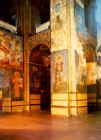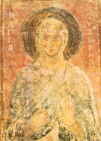Kyiv... Old yet ever young....
Its glorious history goes back 1,500 years. From times of old it is referred
to as "the mother of all cities of Rus." It is also the city where legend
merges with reality in striking fashion.
Millions of tourists are
eager to visit Kyiv, to climb the famous Starokyivskaya Hill, to touch
the warm stones of the majestic monuments of the past, and, from the steep
slopes of the Slavutich (the ancient name for the Dnieper River), to enjoy
the panorama of the new residential districts which now circle the entire
city.
The famous St. Sophia Cathedral
of Kyiv.... Everyone is immediately struck upon crossing its threshold.
The bustle of the present remains beyond the cathedral doors, centuries
recede, and visitors are initiated into the distant past. It was a time
of prosperity for the Kyivan Rus state, a time when it established and
maintained close trading and diplomatic contacts with the countries of
the Orient and the West. Many European kings considered it an honor to
establish matrimonial ties with the family of the Grand Prince of Kyiv.
Rumors of Kyiv's wealth and beauty as well as the high state of the arts
reached many countries of the world. A chronicle of the time read: "Kyiv
does honor to all the lands of Rus; it is the glory and pride of Old Rus...."
The monuments of the State
Historical and Architectural Museum of the St. Sophia Cathedral are often
referred to as a chronicle of architecture and monumental painting of
the eleventh Ч nineteenth centuries. The Museum includes the St. Sophia
Cathedral and the adjoining buildings of the St. Sophia Monastery, the
Golden Gates, St. Cyril's Church, St. Andrew's Church and the Refectory
of St. Michael's Monastery of the Golden Domes. The most ancient of them
belong to the period of the reign of Grand Prince Yaroslav the Wise (1019Ч1054).
In the first half of the eleventh century. Prince Yaroslav extended the
borders of ancient Kyiv, and it was he who started the construction of
a majestic ensemble of stone buildings. His construction work is mentioned
in the Tale of Bygone Years under the year 1037: "Yaroslav founded a great
town near which are the Golden Gates; he also built the Church of St. Sophia,
the metropolitan's church, and then the Church of the Annunciation of the
Golden Gates, after which he erected the monasteries of St. George and
St. Irene." In these scant words the chronicler wrote of the talent and
labour of thousands of anonymous architects and stone-masons, plasterers
and painters, wood- and stone-cutters. The buildings of note dating from
the period of Old Rus, the state which was the cradle for three fraternal
peoples Ч the Russians, Ukrainians and Byelorussians Ч illustrate one of
the most vivid pages in the history of our culture.
For many centuries, architectural
monuments of the past have been mute witnesses to and "participants" in
historical events. They survived devastating raids of the steppe nomads
in the ominous year of 1240, outlived periods of neglect and later restorations
in
the fourteenth - sixteenth centuries. In the seventeenth century, they
witnessed the national-liberation struggle of the Ukrainian people against
the Polish and Lithuanian feudal lords under the leadership of Bogdan Khmelnitsky.
In the period of cultural rebirth brought about by the reunification of
the Ukraine with Russia, these monuments were given a new lease on life.
In 1934, the ancient St.
Sophia Cathedral was made an architectural and historical museum. it opened
new opportunities for research upon and restoration of the cathedral's
architecture and murals. The museum was intended to illustrate the cultural
heritage of our people and to serve as a centre of aesthetic and patriotic
education of the people. In the period of the Great Patriotic War of 1941Ч1945
the museum suffered great losses. Though the preserve remained intact throughout
the occupation, the fascists plundered its archives and funds which preserved
among other exhibits the twelfth-century frescoes from St. Michael's Monastery
of the Golden Domes. After the war the frescoes, heavily damaged, were
returned to the museum.
In the late 1940s, restoration
work was resumed. Among those involved in the research were V. Lazarev,
M. Karger, V. Levitskaya, Yu. Aseyev, N. Kresalny and S. Vysotsky, to mention
hut a few. To work out a reliable method of mural restoration, a specific
laboratory was set up under the auspices of L. Kalenichenko, Ye. Mamolat,
0. Plushch. The scientific and res-toration council was headed by Academicians
I. Grabar and V. Lazarev. A large group of Ukrainian restorers of monumental
painting has matured during the restoration works in the St. Sophia.
The research work in the
museum resulted in the reconstruction of a model based on the elev-enth-century
appearance of the St. Sophia Cathedral, helped to define the level of the
build-ing's floors and decipher the subjects of the mural representations.
The wall space was cleaned of dirt and overpaint to restore eleventh-century
frescoes and mosaics. A great amount of work was devoted to the study of
Old Rus painting technique and to the ancient graffiti, val-uable examples
of the ancient Old Rus script, concealed under a layer of later overpaint.
Archeological excavations on the grounds of the preserve brought to light
new facts on the (indent topography of the locality, and on construction
projects carried out in the monastery precincts throughout its history.
Remnants of the eleventh-century stone wall were found in the yard of the
metropolitan's residence.
The museum collection numbers
over 60,000 items, including archeological finds, surveys and drawings
of the monuments, articles of decorative and applied art, photographs and
architec-tural details of decoration. The museum collection contains fragments
of mosaic floors and marble capitals from the Church of the Tithes, authentic
mosaics and frescoes from St. Michael's Monastery of the Golden Domes (the
twelfth cent.), and samples of gold-thread em-broidery of the eleventh-twelfth
centuries, as well as copies of monumental paintings belonging to various
architectural ensembles of the Ukraine. A new museum of Ukrainian Architecture
has recently been established at the St. Sophia preserve. Extensive research
and restoration works have been carried out in the branches of the museum
Ч the Golden Gates, St. Cyril's Church, St. Andrew's Church and the Refectory
of St. Michael's Cathedral.
Over the course of many
centuries, the architectural perfection of the St. Sophia Cathedral, the
vivid colors of the mosaic and fresco compositions dating from the eleventh
century have never failed to evoke admiration. The creative work of the
master-craftsmen from past epochs cannot but provoke unflagging interest.
The number of visitors to
the museum grows with every year. Annually more than two million people
visit the preserve, including 1,5 million people to the St. Sophia alone.
The monuments of the St. Sophia Museum are landmarks of our country's history
and culture. They illustrate the talent and artistic taste of our people,
reveal new facets of beauty, and show the sources of friendship and unity
of our fraternal Slavic nations. |

St. Sophia Cathedral

St. Cyril's Church

St. Cyril's Church

St. Andrew's Church

St. Sophia Cathedral

Golden Gates

St. Andrew's Church
|